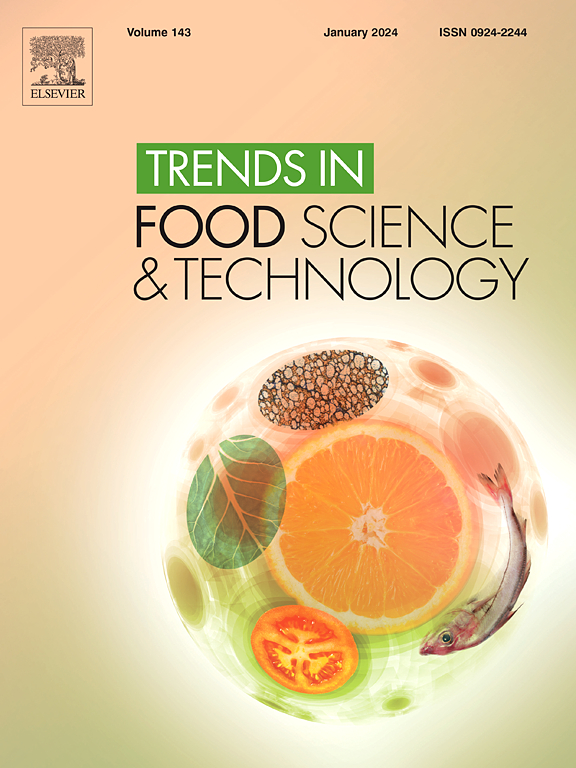具有环状结构的淀粉衍生物在食品中具有独特的应用潜力
IF 15.1
1区 农林科学
Q1 FOOD SCIENCE & TECHNOLOGY
引用次数: 0
摘要
天然存在的α-葡聚糖及其衍生物主要表现为由线性链和支链组成的簇状结构。在进化过程中,由于能量储存和竞争等生理功能,出现了相对难消化和耐药的环α-葡聚糖衍生物。它们独特的结构特性引起了人们极大的研究兴趣。淀粉是食品中重要的能量提供成分,本文主要介绍了淀粉的环结构衍生物的分类和应用。此外,考虑到环衍生物的结构相似性及其糖苷键的变化,还对右旋糖酐的环衍生物进行了综述。分析了环骨架中组成单元数量的结构差异、侧链修饰的类型和糖苷键的性质对环衍生物的溶解度及其与其他分子的相互作用有显著影响。此外,还讨论了其在食品体系中的应用,包括功能性成分封装、调节淀粉糊化和降解、调节能量供应以及作为可溶性膳食纤维的应用。主要发现和结论:受酶特异性和纯化技术的限制,目前只有普通环糊精、化学修饰环糊精和高支链环糊精能够大规模制备和应用于食品中。环衍生物大规模生产和应用的推进可以为食品工业引入新的功能成分,推动食品加工和应用的创新。本文章由计算机程序翻译,如有差异,请以英文原文为准。
Starch derivatives with cyclic structures have unique application potential in foods
Background
Naturally occurring α-glucan and its derivatives primarily exhibit cluster structures composed of linear and branched chains. During evolution, relatively indigestible and resistant cyclic α-glucan derivatives emerged due to physiological functions such as energy storage and competition. Their distinct structural properties have received significant research interest.
Scope and approach
In this paper, we focused on the classification and applications of cyclic structure derivatives of starch, a key energy-providing component in food. Additionally, given the structural similarities of cyclic derivatives and the variations in their glycosidic bonds, cyclic derivatives from dextran were also reviewed. Structural differences in the number of constituent units in the cyclic skeleton, the type of side chain modifications, and the nature of glycosidic bonds significantly effecting the solubility of cyclic derivatives and their interactions with other molecules, are analyzed. Moreover, their applications in food systems, including functional ingredient encapsulation, regulation of starch gelatinization and retrogradation, modulation of energy supply, and use as soluble dietary fiber were discussed.
Key findings and conclusions: Limited by the enzyme specificity and purification techniques, currently only common cyclodextrins, chemically modified cyclodextrins, and highly branched cyclodextrins can be prepared and applied in food on a large scale. The advancement of large-scale production and application of cyclic derivatives can introduce novel functional ingredients for the food industry and drive innovation in food processing and applications.
求助全文
通过发布文献求助,成功后即可免费获取论文全文。
去求助
来源期刊

Trends in Food Science & Technology
工程技术-食品科技
CiteScore
32.50
自引率
2.60%
发文量
322
审稿时长
37 days
期刊介绍:
Trends in Food Science & Technology is a prestigious international journal that specializes in peer-reviewed articles covering the latest advancements in technology, food science, and human nutrition. It serves as a bridge between specialized primary journals and general trade magazines, providing readable and scientifically rigorous reviews and commentaries on current research developments and their potential applications in the food industry.
Unlike traditional journals, Trends in Food Science & Technology does not publish original research papers. Instead, it focuses on critical and comprehensive reviews to offer valuable insights for professionals in the field. By bringing together cutting-edge research and industry applications, this journal plays a vital role in disseminating knowledge and facilitating advancements in the food science and technology sector.
 求助内容:
求助内容: 应助结果提醒方式:
应助结果提醒方式:


